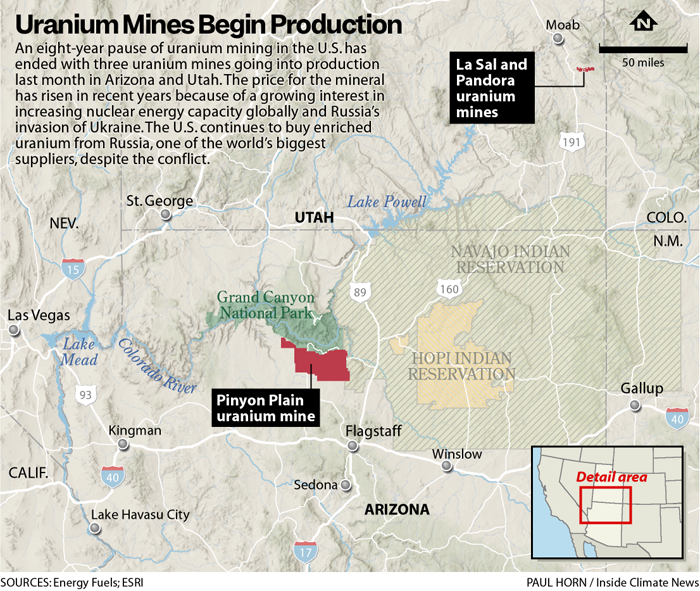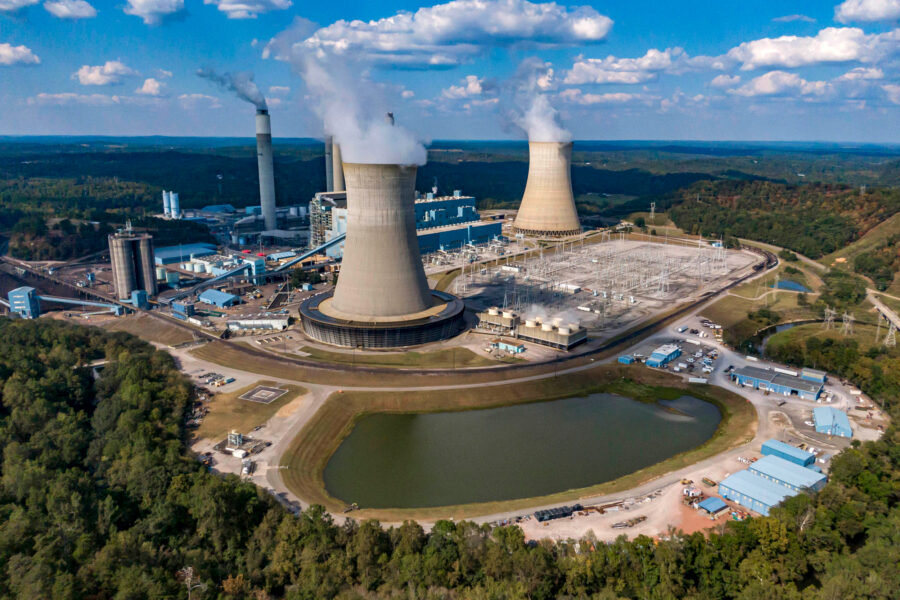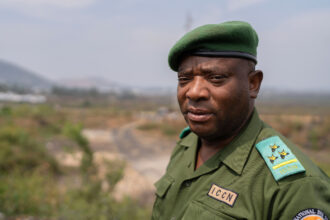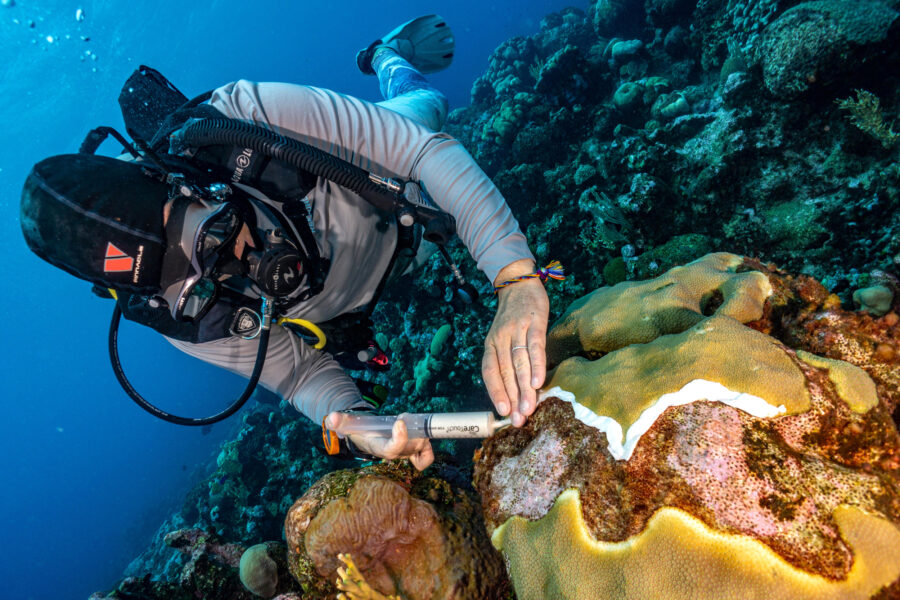First Uranium Mines to Dig in the US in Eight Years Begin Operations Near Grand Canyon
Three uranium mines have gone into production along the Arizona-Utah border, with more on the way elsewhere in the Mountain West, as market conditions for the mineral needed for nuclear energy improve in response to a global push to reduce the consumption of fossil fuels to slow climate change.
But the mines, which were the first to begin operations in the U.S. in eight years when they began extracting ore in late December, are drawing fierce criticism from tribes and environmentalists. One of the mines in Arizona is located in a new national monument President Biden designated last year, while the other two are located in Utah’s quarter of the Four Corners region, where the impacts of 20th-century uranium mining persist to this day.
It’s the latest development in the long-running tension between the need to extract the minerals needed for clean energy sources and the damage mining brings to environments and nearby communities. Across the Southwest, environmentalists and tribes have pushed back against mining proposals, including the three that have gone into production in Arizona and Utah, citing potential impacts to water supplies and water quality, the negative health outcomes uranium mining has historically brought to Indigenous communities and the destruction of culturally sensitive land.
For years, the permitted uranium mines in Arizona and Utah sat dormant, with the demand and price for uranium too low to justify operating. But times have changed, said Curtis Moore, a spokesperson with Energy Fuels Resources, the company behind the mines, as uranium prices recently reached $90 per pound.
The price increased primarily for two reasons. First is the agreement at COP28 of more than 20 nations, including the U.S., to triple nuclear energy production to help achieve net-zero greenhouse gas emissions globally by 2050. The second is Russia’s war in Ukraine.
Russia dominates the uranium market, experts said, and the U.S. continues to buy the mineral to fuel its nuclear reactors from the country, despite the sweeping sanctions the U.S. imposed on Russia for its 2022 invasion of Ukraine. “Fifty percent of the uranium [the U.S. uses] comes from or through Russia,” Moore said. “We’re sending about a billion dollars per year, even today, to Russia, for nuclear fuel as we try to wean ourselves off of Russian supply.”
Experts, however, are skeptical of the role nuclear energy will play in the clean energy transition.
“The narrative going around is that nuclear is back or it’s hot,” said Ian Lange, associate professor and the director of the Mineral and Energy Economics program at Colorado School of Mines. “I don’t really think there’s gonna be that many more nuclear plants. I’m not swayed by this idea of like, ‘oh, nuclear is good for the clean energy transition so we’re going have to do it.”

Nuclear power plants may be more likely to stay online, or in some cases brought back online, he said, but permitting for any new ones is incredibly expensive and it can take years for the plants to get built. Take the story of Vogtl, the first nuclear facility to go online in the U.S. in 40 years, Lange said. The plant in Waynesboro, Georgia, came online seven years after it was supposed to and cost $30 billion to build, double what had been projected.
Then there’s the problem of turning the ore into a usable product. Energy Fuels Resources has the only operating uranium mill in the country, White Mesa Uranium Mill located in southeastern Utah, which tribes and environmentalists say has impacted the local air and water quality for years. And the U.S. currently has only one facility, in New Mexico, where the refined ore can be turned into the rods needed to power nuclear plants.
“More dirt doesn’t do anything if you don’t have a way to make it usable for the nuclear facility,” Lange said.
Moore said the lack of enrichment facilities in the U.S. to make the uranium usable as fuel does pose some problems in the supply chain, but it’s something that the industry is looking to address, possibly by reopening shutdown enrichment facilities
The biggest problem the mining industry faces—especially with uranium—is opposition from local communities, tribes and environmentalists. The three mines that just started operations endured years of pushback and litigation, with the Pinyon Plain Mine perhaps the most controversial.
Pinyon Plain, formerly known as the Canyon Uranium Mine, was originally permitted in 1986 and is located seven miles south of Grand Canyon National Park. The mine site now lies within the Baaj Nwaavjo I’tah Kukveni – Ancestral Footprints of the Grand Canyon National Monument that President Biden designated last year, which bans any new mining claims within its boundaries. The Mining Law of 1872, however, doesn’t allow such a ban to revoke preexisting mining rights that have proven it is economically feasible to mine there, so the Pinyon Plain Mine was unaffected.
Those opposing the mine say it poses a threat to the water quantity and quality of the region, including to the only drinking source for the Havasupai Tribe and to springs that lead into the Grand Canyon. Since 2013, when the company began drilling the mine shaft, the mine has pumped over 49 million gallons of water that is now contaminated with high levels of arsenic and uranium.
State regulators have found the mine will not impact local water supplies, though environmental groups dispute these analyses. But in the drought-stricken Southwest, where every drop of water counts, mines can consume vast amounts of the resource and also potentially impact its quality.
“It really just shows how far we have to go with reforming the 1872 mining law,” said Amber Reimondo, the energy director with the Grand Canyon Trust, an environmental group focused on protecting the canyon that has worked with local tribes and other environmental groups to protest the mine.
“Because if not for that, mines that are in these entirely inappropriate places wouldn’t be able to go forward. The Pinyon Plain Mine impacts cultural resources. It impacts water resources. And it impacts one of the wonders of the world. It’s just a place that seems common sense that you wouldn’t want to put a uranium mine, yet here we are.”
Share this article
Disclaimer: The copyright of this article belongs to the original author. Reposting this article is solely for the purpose of information dissemination and does not constitute any investment advice. If there is any infringement, please contact us immediately. We will make corrections or deletions as necessary. Thank you.







